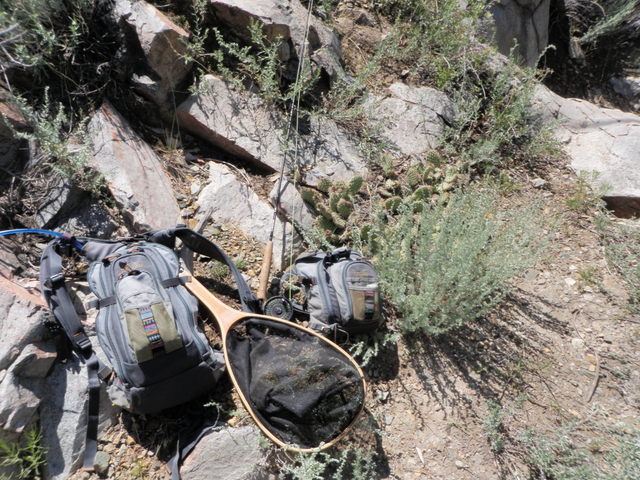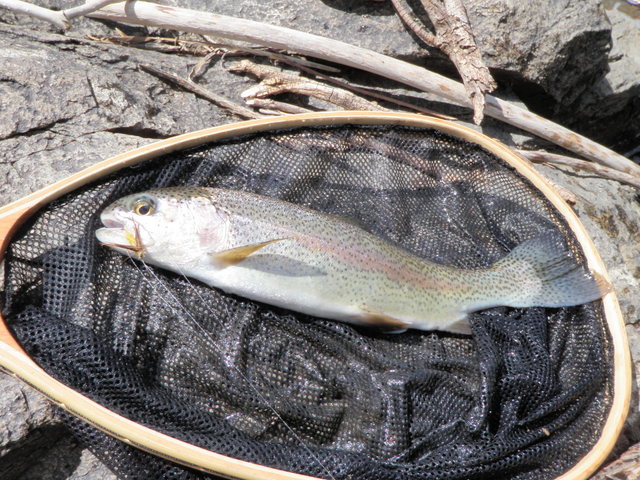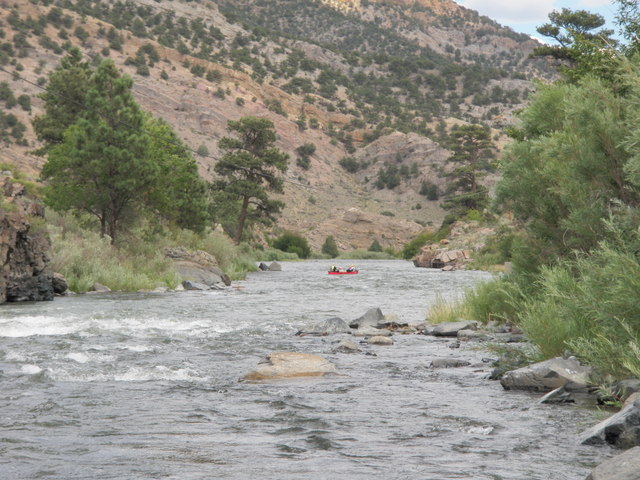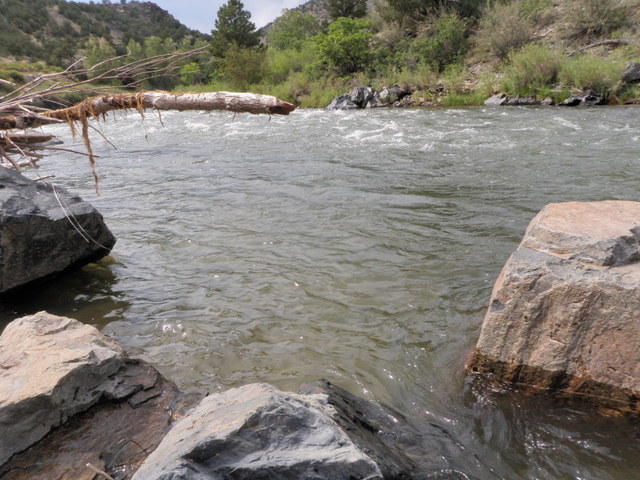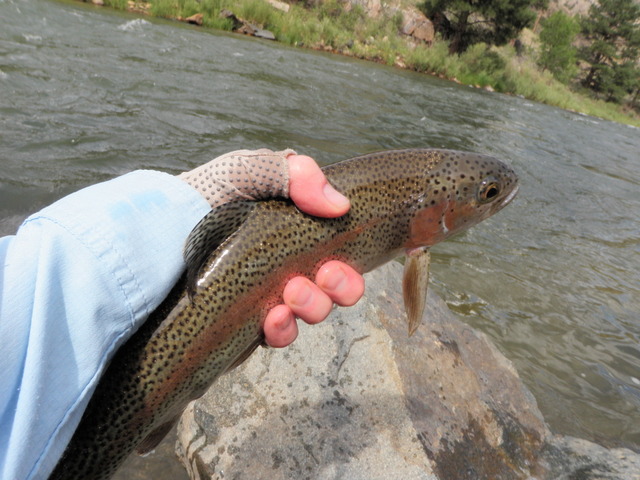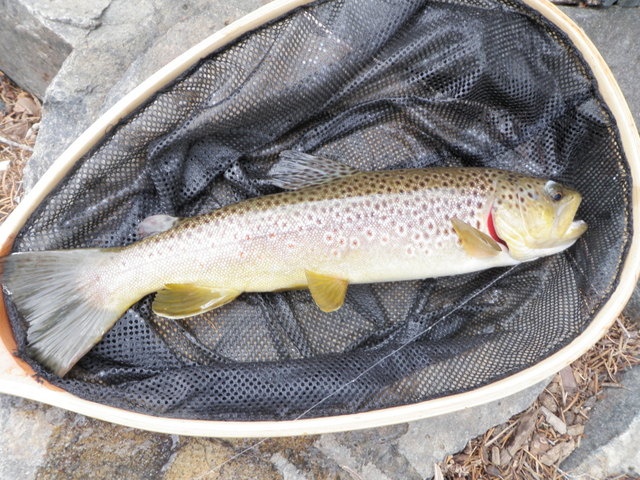Time: 10:00AM – 4:30PM
Location: Chafee-Fremont County Line
Fish Landed: 14
Arkansas River 08/10/2013 photo album
Jane and I decided to embark on another camping trip on the weekend beginning August 9, and I had been following the fishing reports on the Arkansas River through the Royal Gorge Angler and ArkAnglers web sites. Both sites suggested that numerous bugs continued to hatch on the Arkansas including pale morning duns, caddis, yellow sallies and red quills. The flows were back up to the 740 cfs range after a fair amount of rain earlier in the week, but both sites indicated that the water clarity was good. One of our favorite campsites near the Arkansas River is Angel of Shavano as it is fairly remote, and we’ve had good luck finding sites available without a reservation. The campground is roughly five miles off of route 50 as one drives west toward Monarch Pass. Jane and I decided to make this our camping destination for the weekend.
Jane was able to get off work early on Friday, so I packed the car and picked her up outside her office in downtown Denver and we were on our way by 2:30PM on Friday. We drove through several rainstorms as we took 285 southwest and crossed South Park; however, the rain had ended by the time we reached the campground. With some threatening clouds remaining in the western sky, we set up both our tent and our canopy before eating dinner and going to bed.
On Saturday I planned to take the Santa Fe and drive to the Arkansas River to fish for the day while Jane expected to hike the Colorado Trail toward Mt. Shavano as the trailhead is right next to the campground. I was able to depart by 9:15 and arrived at the river by the Fremont-Chafee County line by 9:45AM, and I got my waders wet by 10AM. The sky was bright blue with no clouds visible and the air temperature was in the low 70’s as I began. The water was a bit off color, but actually perfect for fishing as the fish could still see the surface but less care was required in approaching fish.
I considered crossing the river at the tail of the long pool below where I parked, but changed my mind as I gazed at the higher volume. Why risk it when I had practically the entire river to myself? I climbed back up the bank to the road and walked east along the shoulder for .3 mile and then descended on a worn trail next to a vertical rock wall. I decided to begin with a yellow pool toy hopper and trail a beadhead hares ear. There was a nice wide run that deflected off the vertical rock wall below me, but I couldn’t interest any fish in my offerings in this area.
I moved further upstream to a nice wide tailout below some long riffles, and here I landed a small brown on the beadhead hares ear while I experienced two additional momentary hookups. I continued on fishing mostly the 10 to 15 feet of water out from the left bank, but nothing was going for my flies, so I swapped out the pool toy for a gray parachute hopper. This at least generated some refusals but I couldn’t close the deal and the trailing nymph wasn’t generating any interest. I again switched flies and experimented with a yellow Letort hopper as the top fly and tried a 20 incher as the trailing fly. It was about this time that I glanced at my watch and noticed it was 11:30, and I was quite close to the spot where I parked the car, so I exited the river and climbed the steep slope to a nice high rock overlooking the river. Here I munched my lunch while observing, but I didn’t really see any evidence of fish.
After lunch I circled around the large lunch rock and positioned myself at the top and adjacent to the beginning of the deep pool just below the lunch rock. I began making casts into the slow moving water and just as my confidence waned and thoughts began to enter my head to move on, a nice rainbow emerged from the depths of the pool and slowly glided up to the Letort hopper and confidently devoured it! Much to my surprise and delight I was connected to a battling 14 inch rainbow and I moved closer to the river and netted the fish after a brief battle.
I continued on and added a few more fish to my total but the 20 incher wasn’t producing and it was a heavy fly to support with the dubbed body hopper, so I decided to trade it for a lighter nymph. As I inspected my fly patch, I noticed two iron sallies that I’d tied over the winter. These nymphs are intended to imitate yellow sallies and the reports suggested that yellow sallies were present in early August. Lacking another strategy, I tied on the iron sally and it proved to be an excellent choice. I began to pick up fish on a more regular basis on the iron sally but now the yellow Letort hopper ceased to produce and it was becoming waterlogged quite frequently. If the top fly wasn’t producing fish, shouldn’t it at least be buoyant and easily seen? Of course, so I went to my old standby, the Chernobyl ant.
The Chernobyl ant combination would produce most of my remaining fish with a few exceptions. I worked my way along the left bank and plopped the two fly combination in all the likely pockets and slots behind current breaks. The Hofer strain rainbows now populating the Arkansas River proved to be my saviour on this Saturday. The rainbows occupied the deeper eddies and pools, and in many cases I could spot them hovering a foot or so below the surface. They didn’t smash my flies instantly, but if I spotted them and put enough casts over them, I could generally eventually extract a smashing take of the Chernobyl or a grab of the iron sally as I lifted to recast.
I was stuck on nine and working hard to reach double digits when I encountered a nice long eddy where the current circled back along the bank until it intersected with a large rock that protruded into the river. The intersection of the current flowing downstream past the rock and the recirculated current along the bank created a sucking vortex. I cast upstream but short of the whirlpool and allowed the Chernobyl to drift slowly toward the intersection when a large mouth surfaced and inhaled the surface fly. I set the hook and saw a large rainbow clear the surface and crash back to the river, but the connection didn’t last long before the fish was gone. I reeled up my line and discovered the trailing iron sally was gone, so I’m not sure if the fish rolled on it or whether it got hooked into a rock or branch in the short battle. I was disappointed to lose a nice sized number ten and I only had one more iron sally in my fleece patch.
I mustered my energy and focus and moved on upstream after replacing the iron sally with a beadhead hares ear. In a short amount of time I encountered another nice narrow deep ten foot stretch of water, and as I began casting I spotted another rainbow positioned in front of a large submerged boulder. I made at least ten drifts over this fish, but it showed no interest in my offerings. I paused and observed closely and saw the rainbow rise to the surface and sip something quite miniscule from the film. What should I do? In these situations in the past I have resorted to a parachute ant, so I decided to give it a try again. Unfortunately while I concentrated on tying on the ant, the trout disappeared. I was ready to cast but now my target was gone. But wait a second, I looked below the submerged rock and now there were not one but two rainbows hovering six inches below the surface in front of another submerged rock.
I made a couple extremely short casts and allowed the two flies to drift no more than five feet below me, but the flies were beyond the two fish. I could clearly see the orange poly tuft on the parachute ant leading the Chernobyl ant, so I was pleased with that circumstance. I lifted the two flies and gently placed them on top of the upstream submerged rock and watched as they slowly drifted to the position of one of the rainbows. As I held my breath the rainbow slowly elevated and tipped its nose above the water and sucked in my ant. In a split second I lifted my rod tip and the agitated rainbow splashed and fought but eventually slipped over the wooden rim of my net. Number ten was certainly worth waiting for.
It was now late afternoon and some large gray clouds began to build in the west. I attempted to recover my earlier magic on the nymph and tied on my last iron sally, but this didn’t produce as it had done in the early afternoon. I came to a nice long side pool where a long log or stick jutted out over the tail above a large protruding rock and I made a nice long cast ten feet above the rock. The slow current brought the Chernobyl ant bobbing back toward me and just as I was preparing to lift to recast before the nymph tangled in the rock, the foam fly disappeared, and I made a slightly late hook set, but connected with another nice rainbow. Perhaps I didn’t need a trailing nymph?
With the darker skies and lower light intensity I hoped that perhaps some pale morning duns would emerge, so I decided to exchange the now unproductive iron sally for a salvation nymph. This proved to be a fortuitous move as the last three fish landed snared the salvation nymph. The most memorable was a 14 inch brown that stopped the Chernobyl ant by snatching the salvation nymph in a tiny pocket that was no more that two feet deep right along the bank. I released this fish and as I did so, heard the intimidating sound of thunder and saw a flash of lightning in the distant western sky. I wanted to catch another fish, but I also didn’t want to get caught in a thunderstorm deluge.
I picked up the pace and quickly covered some attractive water along the bank, and it wasn’t long before I landed a small brown to reach 14 fish on the day. With this fish released, I hustled through some thick brush, climbed a steep narrow path and reached the shoulder of route 50. I quickly strode east along the highway until I reached the Santa Fe. I tossed my rod, wading stick, frontpack and backpack in the back of the car and as I stepped into the driver’s seat with my waders on, it began to pour. Timing is everything.

